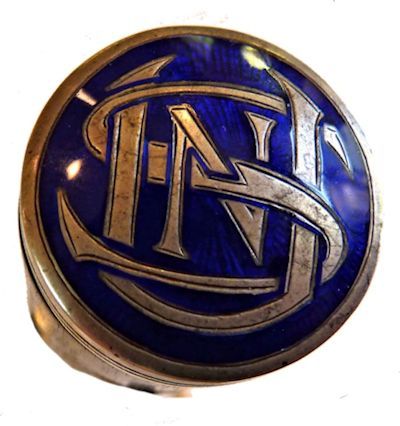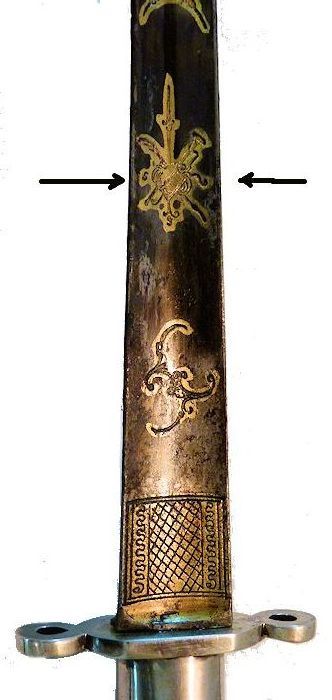
Presented is a beautiful,
high grade, Fighting dirk with a prominent Blue enamel pommel cap having a cartouche of intertwined USN initials. The triangular blade could have come from an English short sword or
it may have been originally made as a dirk with the scabbard and blade dating to Ca 1790. A typical Navy officers’
dirk would normally be two edged, and have gold gilted hardware and a black leather sheath with gold mounts. However,
there were officer’s of a high enough rank and deep enough pockets to have a weapon designed to their own specifications.
This is probably how this elegant, but sturdy silver dirk came about when someone after the Civil War decided to have the
USN pommel cap added to what might be a fancy cane’s hilt married to the earlier blade. The end result is a
composite so beautiful and natural looking that it must be seen to be fully appreciated.
The dirk is 19 1/8 inches overall
without its sheath, and weighs 7 ounces. Other than for the USN, there are no other marks or imprints. The enamel
work and style of the initials on the pommel is reminiscent of what is found on examples of US Navy silverware and dishes in
the officer’s Mess from about 1860 to 1903.
The
unusual Celtic Knot cross guard tends to reinforce the English origin. The ebony hilt with silver studs aids
the grip and the overall simple elegance of the design. The
two lines of fashion scribing on the ferrule and at the base of the pommel were made by machine and not engraved by hand.
When housed, it is 20 1/4 inches long and 1 inch wide at the throat of the
sheath. None of the silver is magnetic except for the ferrule which is close to the widest part of the iron tang.
The point of balance is at the cross guard making it fit for fighting.
  |
|
Blue enamel pommel cap with intertwined
USN initials shown over Celtic Knot cross guard
|
THE BLADE:The
sturdy, concave, triangular blade is 13 15/16 inches long and its overall length is 19 1/4 inches. Almost all of ts
Blue niter and gilding remain and have only dulled with age. The design consists of a geometric cross hatch pattern of gilt
extending 5/8 inch along the three ricasso. On the obverse side which is 3/4 inches wide at the hilt, the design
has a drum, horn and pike as important heraldic symbols. The rest are elements of flora that extend 8
3/4 inches from the Celtic Knot cross guard. The other two blades of the triangle are 1/2 inch wide. They start with the same
geometric pattern at the ricasso, and when viewed along the center cutting edge, consist of four groups of swirls and curls
in gold gilt. There is no pitting or spotting.
   |
|
Showing various portions of the Blue niter and gilt triangular blade
|
THE LEATHER AND SILVER SHEATH:
The leather of the sheath may not be original. It is in good condition with tight stitching, but it was bent 4 inches
below the throat, and because of this, must be handled with care. The obverse silver throat band consist of a complicated
design of vines and leaves with the face of Medusa centered. There is one suspension ring. The reverse has an engraving
of a sunflower within flowing swirls. The silver chape at the pointed end is without ornamentation and does not match the
quality of the throat band.
point – front and backPROVENANCE:
From a private collection of nautical antiques where it was acquired nineteen years ago.
|
|
DIMENSIONS:
Hilt 5
1/4″ L x 1″ diameter
Cross guard 2″ WLength overall 20 1/4″ in sheath
Blade 13 15/16″ L x 1″ W x 1/2″ T for two panelsWeight 7 3/4 ounces








